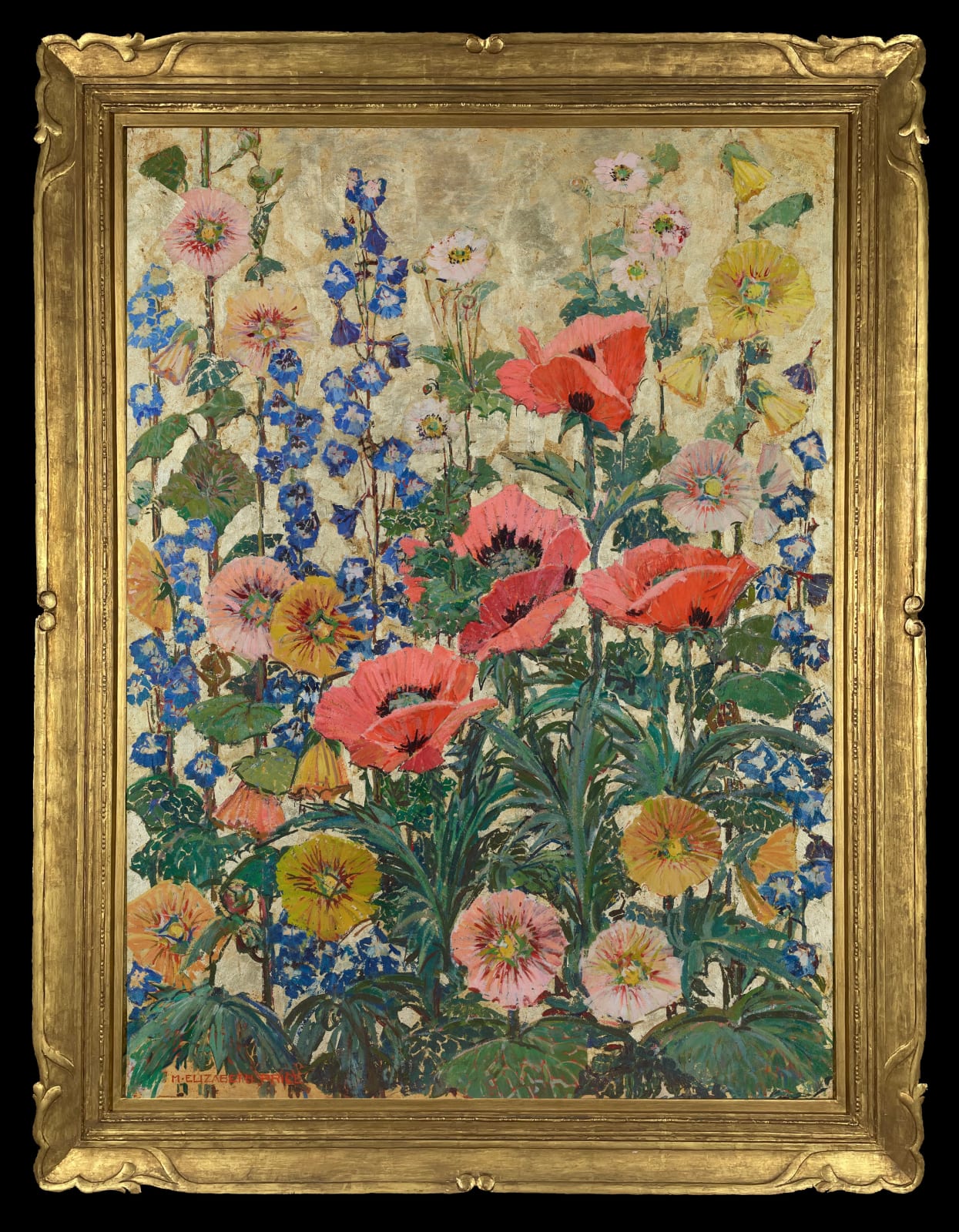Mary Elizabeth Price 1877-1965
Hollyhock and Oriental Poppy
Oil with gold and silver leaf on Masonite
40 x 30 inches (101.6 x 76.2 cm)
Framed dimensions: 45 3/4 x 36 inches
Framed dimensions: 45 3/4 x 36 inches
Signed lower left: M Elizabeth Price
Signed and inscribed on verso with title
Sold
Mary Elizabeth Price enjoyed a long career with considerable critical and commercial success. She made a reputation painting decorative floral panels of peonies, poppies, hollyhocks, and delphiniums often with gold...
Mary Elizabeth Price enjoyed a long career with considerable critical and commercial success. She made a reputation painting decorative floral panels of peonies, poppies, hollyhocks, and delphiniums often with gold and silver leaf backgrounds. Price's oeuvre also included landscapes, genre scenes, figure studies, and a unique series depicting Spanish galleons of the sixteenth century. She worked in an impressionist style, influenced by such fellow members of the New Hope School as Daniel Garber. Her unique use of gold and silver leaf was directly related to her interest in thirteenth-century Sienese painting. Price's novel application of the historic technique adds great vibrancy and originality to her work.
Price came from a family well-connected in the arts, and she used this to great advantage. Her one brother ran Feragil Galleries in New York; another brother made beautiful frames, as well as standing screens for Price's paintings. Her sister was married to Rae Sloan Bredin, a notable Pennsylvania Impressionist.
Price's notable exhibition history began in 1914 when she submitted a work to the Corcoran Biennial. She would show there seven times. In 1921 she was accepted to the National Academy of Design and exhibited there sixteen times between 1921 and 1934. In 1927 she won Carnegie Prize for best oil painting for one of her Spanish Galleons pictures. By far Price's most impressive record with was at her alma mater, the Pennsylvania Academy of the Fine Arts, where she exhibited for twenty years. She also mounted solo shows and exhibited annually with The Philadelphia Ten from 1921 to 1945.
In 1931, Price collaborated with fellow Philadelphia Ten painter, Lucille Howard, to paint a series of murals for the rooms of the American Women's Association clubhouse (an organization Price was chairwoman of at the time). This mural received wide acclaim, as the painting technique mimicked the interwoven stitch-work of samplers and needlework; an art form that had not received proper recognition and was often done anonymously by many American girls and women. Price was an advocate for the exhibition of women's artwork and was a pioneer in the area of art education for women.
In Hollyhock and Oriental Poppy Price used dazzling palette accented by gold leaf to create a painting that is at once beautiful and uniquely her own. Similar to the artists of the Italian Renaissance whose technique she studied, Price applied the rich paint colors on a gilded surface of gesso (sometimes using no less than sixteen different shades of gold and silver leaf), preliminarily incised with intricate designs. The result is an exceptionally beautiful composition that demonstrates Price's deft handling of the complex medium and extraordinary originality.
Price came from a family well-connected in the arts, and she used this to great advantage. Her one brother ran Feragil Galleries in New York; another brother made beautiful frames, as well as standing screens for Price's paintings. Her sister was married to Rae Sloan Bredin, a notable Pennsylvania Impressionist.
Price's notable exhibition history began in 1914 when she submitted a work to the Corcoran Biennial. She would show there seven times. In 1921 she was accepted to the National Academy of Design and exhibited there sixteen times between 1921 and 1934. In 1927 she won Carnegie Prize for best oil painting for one of her Spanish Galleons pictures. By far Price's most impressive record with was at her alma mater, the Pennsylvania Academy of the Fine Arts, where she exhibited for twenty years. She also mounted solo shows and exhibited annually with The Philadelphia Ten from 1921 to 1945.
In 1931, Price collaborated with fellow Philadelphia Ten painter, Lucille Howard, to paint a series of murals for the rooms of the American Women's Association clubhouse (an organization Price was chairwoman of at the time). This mural received wide acclaim, as the painting technique mimicked the interwoven stitch-work of samplers and needlework; an art form that had not received proper recognition and was often done anonymously by many American girls and women. Price was an advocate for the exhibition of women's artwork and was a pioneer in the area of art education for women.
In Hollyhock and Oriental Poppy Price used dazzling palette accented by gold leaf to create a painting that is at once beautiful and uniquely her own. Similar to the artists of the Italian Renaissance whose technique she studied, Price applied the rich paint colors on a gilded surface of gesso (sometimes using no less than sixteen different shades of gold and silver leaf), preliminarily incised with intricate designs. The result is an exceptionally beautiful composition that demonstrates Price's deft handling of the complex medium and extraordinary originality.
Provenance
Private collection, Pittsburgh, Pennsylvania;By descent in the family;
Private collection, Washington D.C.;
Freeman's, Philadelphia, American Art and Pennsylvania Impressionists, June 9, 2019, lot 146;
Private collection, New York;
Avery Galleries, Bryn Mawr, PA, 2019;
Private collection, Florida, until 2025
Please join our mailing list
* denotes required fields
We will process the personal data you have supplied in accordance with our privacy policy (available on request). You can unsubscribe or change your preferences at any time by clicking the link in our emails.



